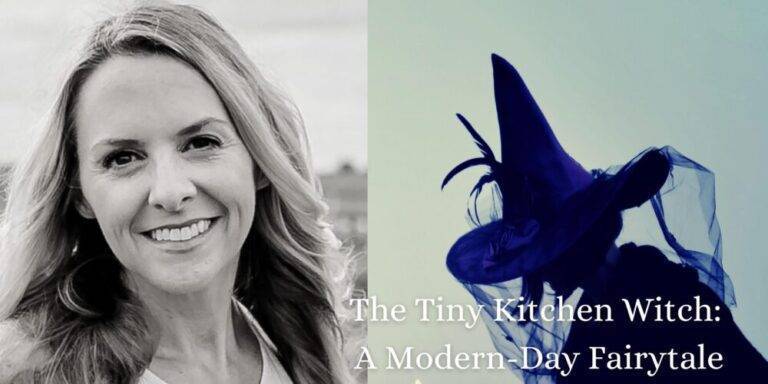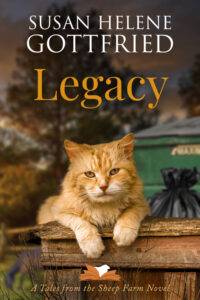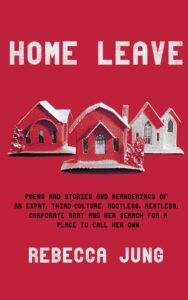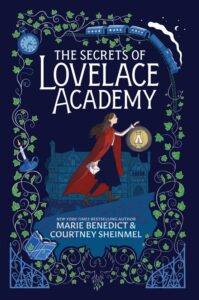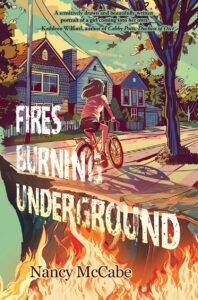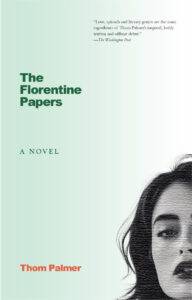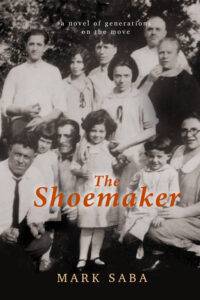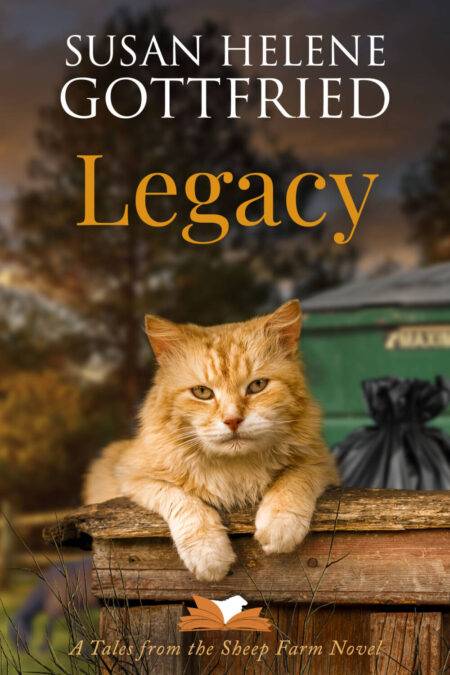About the Author: Jennifer Fickley-Baker’s short stories “The Haunting at Darlington Boardwalk” and “Extinct Things” have appeared in Ground Fiction literary journal, and her latest work, “The Tiny Kitchen Witch: A Modern-Day Fairy Tale,” was released on Kindle Vella in 2021. She grew up in Pittsburgh and earned an M.A. in Creative Writing from Harvard University’s Harvard Extension in 2021. She now resides in Florida with her husband and two sons. Connect with her on Twitter: @JennFickley.
The Tiny Kitchen Witch About “The Tiny Kitchen Witch: A Modern-Day Fairy Tale”: A tiny kitchen witch’s fate is thrown into uncertainty after the death of her beloved owner in this modern-day fairy tale. Plucked from her place above the oven where she’s lived for decades, she’s thrust into the real world and experiences life as she’s passed through generations of a single family.
Q&A: Jennifer Fickley-Baker
What inspired you to write “The Tiny Kitchen Witch — A Modern Fairy Tale”?
There’s a lot about my Pittsburgh upbringing that inspired me to write this piece. First was the family tradition of multi-generational baking, which so many women can identify with and hold onto as a precious family tradition. Pittsburgh’s rich immigrant history is really reflected in its bakeries and the wide variety of pastries you can find there, not to mention the Pittsburgh cookie table tradition. I wrote “Kitchen Witch” as a love story to all these wonderful traditions I grew up with.
What is a kitchen witch?
Good question! To the best of my research, kitchen witch dolls were an Eastern European tradition that somehow made its way to Pittsburgh in the late 70s, early 80s. We had a kitchen witch—a tiny witch with a huge red hooked nose and tangled hair—hanging in our kitchen. I remember being absolutely terrified of it, so much so that I wouldn’t walk into the kitchen so my mom took it down. Writing the story from her perspective really started with me wondering where the heck the kitchen witch tradition came from. I couldn’t find a clear answer, so I wrote one.
The story is told from the perspective of the Tiny Kitchen Witch, who cannot speak or move—was this a challenging character to write?
Yes, but it was an interesting challenge, as she was a critical character to write. Instead of her physical motions, we view everything that happens in the story through her eyes and inner thoughts.
Did fairy tales influence the way this story was told?
Yes, particularly Tiny Kitchen Witch as a character, who turns the fairy-tale trope of “the crone” wise old woman figure on its head. Like “the crone,” she’s magical, wise and very old. When the story starts, she’s somewhat of a “flat” character and tells us what’s happening the way traditional fairy tales are told: this happens, then this happens, and they live happily ever after. There’s not much personality building or character growth in traditional tales. In my story, we watch the Tiny Kitchen Witch become more of a “round” character by the end of the story as she makes choices and shares inner thoughts that build her personality.
Baking and sweets are featured throughout the piece. Do you have a must-visit bakery in Pittsburgh?
I do—Dave’s Terrace Bakery in Whitehall. I grew up on their thumbprint cookies and our family would get our birthday cakes, and cakes for Mother’s Day and Father’s Day from there every year. It’s one of my first stops every time I come back to the city. Just stepping inside and smelling the place takes me back to my childhood!
Click here to read “The Tiny Kitchen Witch — A Modern-Day Fairy Tale.”
Chapter One
The Tiny Kitchen Witch hung above the Old Woman’s stove, in the very same place she’d hung since the Old Woman moved to the house from a very cold place across the sea, fifty years ago. Three times each day, sometimes more, the Tiny Kitchen Witch would conjure up her magic words and blow on the bristles of the broom she clutched in her hands to help the Old Woman with her cooking. That was the job of a Kitchen Witch after all, to use her magic to ensure that stews were never over-salted, cakes never burned and beef never underdone. A kitchen, and the dishes produced in it, were only as perfect as the magic of the Kitchen Witch who lived there.
Then one morning, in the midst of the Tiny Kitchen Witch’s happy existence of guiding the marinating, measuring, mincing and mixing—the Old Woman didn’t hobble into the kitchen in her long house dress, humming to herself, eager to stir up some eggs and black coffee. She was always up with the sun—but here the sun was, peering in through the kitchen window, and there was no sign of her.
The Tiny Kitchen Witch grew more concerned as the hands on the kitchen clock swept past noon. The Old Woman still hadn’t shown. Had something awful happened?
The sun sank in the sky. At a time far past dinner, she heard a bang on the house’s front door followed by a jingle of keys.
It was the Old Woman’s grown son who’d found her, passed away in her bed overnight. An ambulance was called. The grown son cried. The house went dark and stayed that way for days.
A full week went by, with the Tiny Kitchen Witch hanging alone above the cold stove, wondering what would become of her, when two young women appeared at the house. As they found their way into the kitchen and the Tiny Kitchen Witch recognized them as two of the Old Woman’s three granddaughters.
The Tiny Kitchen Witch was delighted to see them. For she had soaked in their shrieks and giggles while using her magic to help the Old Woman bake cookies for them when they were young. They’d sneak tastes of the sugary batter, then peer into the oven, waiting wide-eyed, as she swirled heavenly smells through the room. They used to visit each Sunday, but hadn’t for a very long time.
The two were older now—no longer children—which was what the Tiny Kitchen Witch was thinking of when the oldest granddaughter plucked her from her hook above the oven. How nice it was for the Tiny Kitchen Witch to have her legs stretched and her back straightened after spending so many years hunched over the broom!
“Shall we throw this out?” The oldest granddaughter asked, turning her over in her hand.
The Tiny Kitchen Witch was horrified.
“We can’t!” The second oldest said, peering over her shoulder. “Babbi loved it!”
“Well, I don’t want it. I was always terrified of her! Look at her ugly hooked nose! It’s swollen and red,” the oldest granddaughter said and flung her onto the kitchen table. The Tiny Kitchen Witch lay there, watching as both girls turned away and began emptying out the cabinets, placing their wares into boxes. Her heart broke realizing the girls were not here to save her, but to box up the Old Woman’s belongings. In went the yellow mixing bowl set and the good spatula, the second-best spatula, and then the ragged potholders and the well-worn kitchen towels with frayed ends. Last went in the kitchen clock, and Chick-Chick, the plump oven timer—the Tiny Kitchen Witch’s only other cooking companion. (They’d never spoken of course. She wasn’t even sure he could. But he did have kind eyes).
Finally they left, without so much as a glance at her on their way out.
What was to become of her now, the Tiny Kitchen Witch wondered. She lay on the kitchen table, staring at her reflection in an old toaster the girls had left behind. Her nose was big and hooked, and quite red. And her black hair jutted out at all angles from underneath her pointed hat. She closed her eyes, hating the sight of herself. She’d never felt so ugly before. The Tiny Kitchen Witch lay where she’d been left and wept bitterly until darkness fell in the window.
This excerpt from “The Tiny Kitchen Witch: A Modern-Day Fairy Tale” is published here courtesy of the publisher and should not be reproduced without permission.


